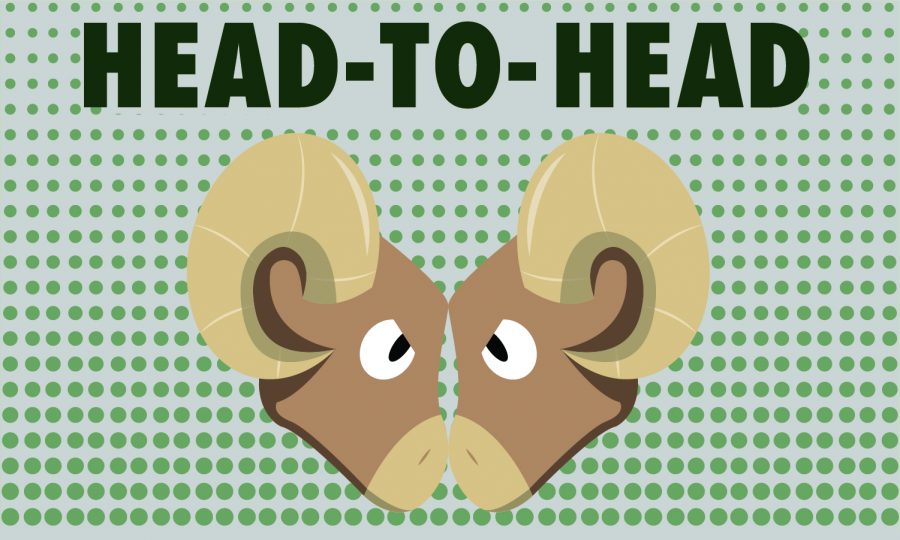(Graphic illustration by Allie Watkinson | The Collegian)
Head to Head: The Stump debate
The stump stands as a representation of free speech on Colorado State University's campus. After being purchased by two student media employees and placed on campus, it still occupies space on the Lory Student Center's Plaza.
February 6, 2022
Editor’s Note: All opinion section content reflects the views of the individual author only and does not represent a stance taken by The Collegian or its editorial board.
Two columnists debate the stump’s significance. Is it still the free speech platform it once was or has the passage of time rotted the wood and integrity? You decide!
Collegian | Forrest Czarnecki
The Stump sits on the plaza as people walk by. The stump in the plaza is a mainstay and it serves as a place for people to hang out and speak their mind Sept. 20, 2016. (Collegian File Photo)
Blouch: The Stump is still a symbol of free speech
Number 18 on the list of 70 things to do before you graduate from Colorado State University is to “Make a statement on The Stump in The (Lory Student Center) Plaza.” The Stump, an aptly named tree stump in The LSC Plaza, has been on campus since 1964, when two student media employees bought it for $4.50 and etched the word “Collegian” into the side as a symbol of free speech.
The Rocky Mountain Collegian and The Stump have a long-standing, inherent relationship. It is this relationship that cements The Stump as a symbol of free speech even today. At the core of free speech is lack of censorship, which is what The Collegian strives for in providing unbiased news to the student body, and thus, The Stump can be seen as a tangible representation of not only the truth being told but also the exchange of ideas.
You cannot ignore the presence of The Stump, not only in the symbolism of its history but in the pride the University has in keeping it as a living symbol and part of our tradition. It’s one of the first things we learn about the University, in fact. As we arrive on campus, orientation leaders are sure to point out The Stump — what it is, what it means and why it is important.
The symbolic significance of The Stump cannot be denied, but it is so much more than just a token of free speech. It cements the whole Plaza as a physical space where free speech is encouraged on campus.
“You don’t have to get on The Stump and pour your heart out to all who can hear to understand its significance and history. Even so, I encourage you to do so — that’s what it’s there for.”
For better or worse, The Plaza has long been a place on campus for individuals to share personal opinions, for protesters to demonstrate beliefs, for businesses to market and for political candidates to campaign. The weight of The Plaza as a playground for information and opinions to be exchanged never felt more prevalent than following the recent polarizing events of preachers coming to The Plaza to promote religious ideology.
It’s no coincidence that the hub of ideas on campus is also the exact location of The Stump. It’s not in The Oval, not the Intramural Fields and not the quad behind the Clark Building but The Plaza.
While many students may not be aware of The Stump’s existence, they don’t necessarily need to be for The Stump to have significance as a symbol of free speech. The connection between the location of The Stump and the role The Plaza plays as a tangible space where students and community members can not only feel safe in expressing ideas but are encouraged to do so cement The Stump as a symbol of free speech.
In other words, even if students don’t know about The Stump itself, they know about the culture of The Plaza, and The Stump precedes this culture and, in many ways, is the catalyst.
You don’t have to get on The Stump and pour your heart out to all who can hear to understand its significance and history. Even so, I encourage you to do so — that’s what it’s there for. Colorado State University is a place where individuals of all backgrounds and walks of life can express themselves and share their opinions. The Stump is a physical representation of CSU’s promise to encourage this exchange, a literal platform for student voices and a symbol of free speech that has stood the test of time.
Reach Cat Blouch at letters@collegian.com or on Twitter @BlouchCat.

Cat Blouch is the social media editor at The Collegian. They are a fourth-year student at Colorado State University studying business administration with...
Collegian | Forrest Czarnecki
The stump sits on the Plaza as students walk through between classes April 20, 2018. (Collegian File Photo)
Eckburg: The Stump stands as a memory of free speech’s past
Ren Wadsworth
It is true that the round tree stump that sits just outside the Lory Student Center stands as a University-wide acknowledgment of upholding students’ rights to free speech and protesting.
The Stump rests atop the concrete season to season, bearing the cold and heat of Fort Collins weather. In 1964, The Collegian’s former editor John Hyde and former Reach editor Shelton Stanfill bought The Stump for less than $5 to be used as a platform for free speech on campus, and it even traveled to the state Capitol two years later for a women’s rights protest.
Although it has its roots in free speech and the word “Collegian” initially carved deep into its bark, it has lost its former sheen over the years — and not just because of the elements.
With The Collegian’s transition to an alt-weekly publication and an ever-present wish to push young journalists to explore their writing and opinions, The Stump stands as a memorial of free speech’s past.
The last few years have been wrought with anger, uncertainty and restlessness. Life amid a pandemic is harder than we thought it would be, and the growing distrust in media and journalism only furthers that strife.
The United States scores low on media literacy overall, and free speech is increasingly associated with a blurring line between regulation of conspiracy ideas and protecting everyone’s First Amendment rights.
So is The Stump enough? Sure, it represents the University’s history with free speech and stands as a reminder that college campuses are places where social change is bred, but the University can and should do more.
“Making your presence physically known on campus to advocate for free speech is important, but so is maintaining accountability online, which, admittedly, is a daunting task.”
One on-campus sign reached out to students and faculty who have been affected by a free speech event on campus and offered resources to them. This raised questions for Turning Point USA campus coordinators, who felt that it represented the University’s intolerance of specific viewpoints. The sign even gained attention nationally.
This is certainly missing the point, as the resources allow students to submit bias reports if they feel like they’ve been discriminated against. It’s not that people are snowflakes, it’s that they’re honoring these groups’ right to free speech while also maintaining accountability for what they say.
You have a right to protest and speak freely, and CSU is honoring that right while also being mindful of the impact these events might have on students. The Stump itself is representative of this right, but it feels like it’s been more recently used by groups wanting to push the boundaries.
In a social media era, CSU has to do more than monitor the goings-on of The Stump on The Plaza. Free speech on campus also occurs in the digital realm, and CSU should maintain the same attitude toward it there.
The Stump is an important reminder of free speech’s past on campus, but those 1964 student media employees could not have foreseen the rapid changes the future brought us, both in technological advances and social or political shifts.
There is more outright anger now, or so it seems. Online happenings can feel louder than the voices of those on The Plaza. Making your presence physically known on campus to advocate for free speech is important, but so is maintaining accountability online, which, admittedly, is a daunting task.
The Stump is a memorial of free speech, but it feels less significant amid the chaos. Using its perceived power to push boundaries or to toe the line between free speech and hate speech can make it feel more like a curse than a blessing.
Reach Bella Eckburg at letters@collegian.com or on Twitter @yaycolor.

Bella Eckburg is a fourth-year journalism student with a minor in criminology and criminal justice and is currently serving as The Collegian’s opinion...


